Feather-related problems are easier to spot than bacterial or fungal-related illnesses. The parakeet’s feathers will look dishevelled and messy, and there may be bald patches.
Parakeet Feather Cyst
Cysts form when a feather root fails to break through the skin. It grows beneath the surface, visible as a lump on the skin. Primary wing feathers are the ones most commonly affected by this problem. Cysts require surgery.
Parakeet Feathers Falling Out
Feather loss in parakeets can be caused by five separate issues: molting, parasites, self-plucking, French moult virus, or Psittacine Beak and Feather Disease (the last three are dealt with on this page).
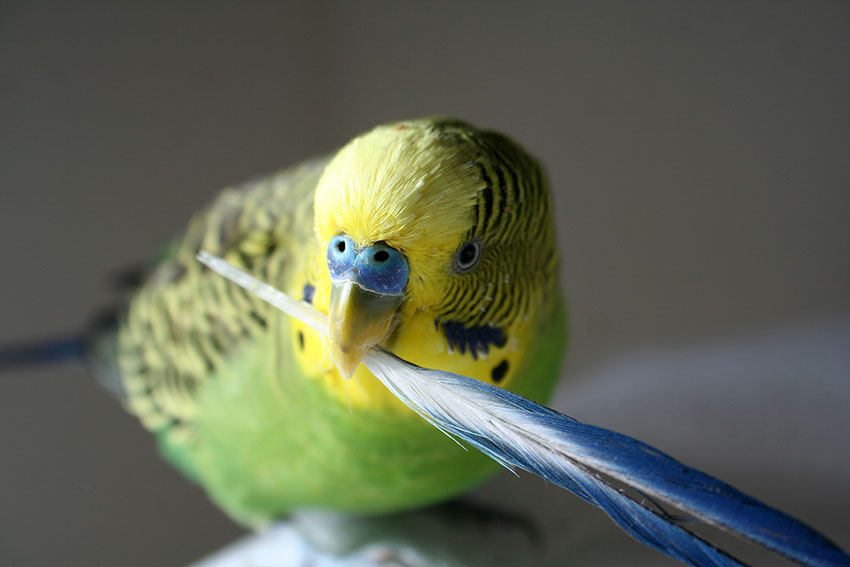
Feathers can cause problems
Parakeet Feather Plucking
If a parakeet starts plucking feathers, it’s an indication of an underlying health problem. It might be parasites, allergy, low air humidity, poor air quality, stress, boredom, mating hormones, liver disease, cancer, bacterial or fungal infection, malnutrition, or heavy metal poisoning.
A vet will be able to pinpoint the underlying problem. If the cause is environmental, rather than an avian ailment, you need to investigate the plucking mystery:
- Watch your parakeet closely, to see if you can see what might be triggering the feather-plucking. Does the bird pluck when angry, bored or stressed? Is another bird or object involved in the behavior that culminates in plucking? Does it happen after eating? Is the parakeet not pluck when you’re around – that is, is the issue possibly linked with loneliness?
- Check the light, air and humidity. Is the parakeet getting a 50/50 balance of light and dark through the 24 hour day? Can you move the cage away from the central-heating, to prevent the air being too dry? Does moving the cage to a different location solve the problem?
- Swap the parakeet’s toys around, to prevent boredom. Make a new perch, to vary the environment.
- Is the bird in need of a bath? Itchy, dry, skin can cause self-plucking. If the parakeet is not used to taking a dip, use a wide-nozzled spray (not a fine mist one) to get things nice and damp. The shower will spark the parakeet’s natural preening instincts. Don’t overdo the dousing, though, as it may make the parakeet panic.
- Make sure the food in the enclosure matches the good foods lists given in this guide, and make sure you’re not missing out any of the required food categories.
- If you often stroke the parakeet on the back or belly, it can stimulate the bird’s mating hormones. This can sometimes lead to feather-plucking.
Sadly, diagnosis is one thing, but cure is another. Many parakeets keep on plucking even when the original stimulation has been identified and removed.
If you’ve tried and failed to address the issue, and if it clearly isn’t a disease or infestation of any kind, you’ll have to resign yourself to living with a semi-bald bird. Some parakeets simply get the habit and can’t stop.
Parakeets Plucking Each Other
A parakeet who is plucked by his cage mates will become very stressed, and can even die from shock. Isolating the plucker is a good short-term solution; but it will need fixing long term. The guilty bird may be sexually frustrated. Providing a nest-box or a choice of potential mates should bring an end to the frustration-related plucking. If overcrowding is the issue, introducing a second (or third) feeding station might help to bring the problem to an end.
Parakeet Feather Bleeding
When a parakeet sprouts new feathers during the molt, or when young birds are growing their first adult plumage, feather bleeding can occur. New feathers - known as pin feathers - contain blood vessels, which enable the living feather to grow. If these are damaged during the early days, they will bleed.
The usual cause of a patch of blood on an adult bird’s coat is a bleeding pin feather. In extreme cases, the blood loss is sufficient to weaken or even kill the parakeet. Large pin feathers – those that grow into primary wing and tail feathers – bleed the most if damaged.
Once spotted, the bleeding must be addressed quickly. The parakeet needs to be caught, and the broken end of the feather should be held tightly for ten minutes. (Note: the pressure should be exerted on the feather itself, not the bird’s body – squeezing the parakeet can cause suffocation.) Once the bleeding has stopped, visit the vet and arrange to have the broken pin feather surgically removed.
Pin feathers above the parakeet’s cere and nostrils are fragile and break easily, but the bleeding is minimal and quickly soon. Parakeets regularly damage these pins in ‘kissing’ bouts with a mirror, an object in the cage, or another bird. Once the blood has dried, it will leave a small stain above the cere.
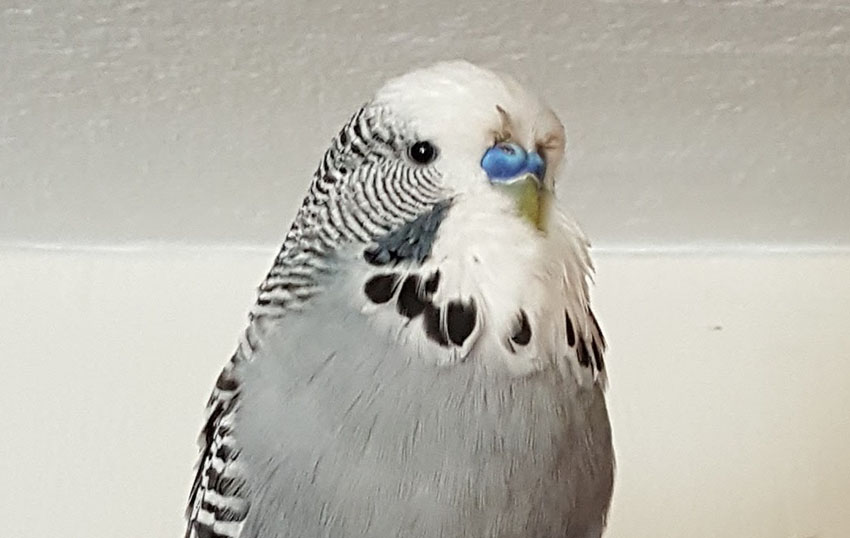
Dried blood from broken pin feathers has spoiled this parakeet's good looks!
Parakeet Feather Duster
Feather Duster Syndrome is a genetic condition, often a sign of inbreeding. The affected birds – aka Mops – have feathers that grow in random directions, and keep on growing. This gives a ‘feather duster’ or mop-like appearance. Beaks and toenails can grow abnormally long in a similar manner. Afflicted parakeets cannot fly or walk, and the unhappy bird has a weak immune system, with too much of its energy being spent on endless feather growth. Parakeets with this condition require a fortified diet. Even then, most do not live beyond one year, and euthanasia is a humane option.
Parakeet feathers French Moult
French moult is a virus that can affect juvenile birds, a mild form of the fatal Budgerigar Fledgling Disease. It causes secondary wing feathers and tail feathers to fall out. In severe cases, feathers fall out elsewhere on the bird’s body, too. There is no guaranteed cure, but a trip to the vet for diagnosis and advice is a must.
Parakeet Beak and Feather Disease
Psittacine Beak and Feather Disease (PBFD), or Psittacine Circovirus Disease (PCD), is a virus that causes feather loss, and it can also cause beaks and toenails to become misshapen. Symptoms range from an untidy appearance to total baldness. Skin sores and blemishes are common with this ailment, too. The virus is passed on through bird droppings, and there is no cure. Affected birds need to be isolated, and a vet should be consulted to receive a formal diagnosis.


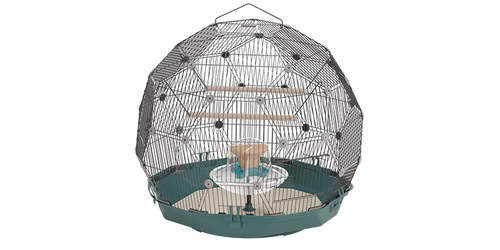
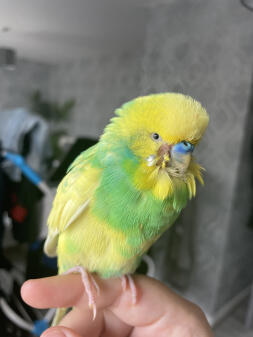
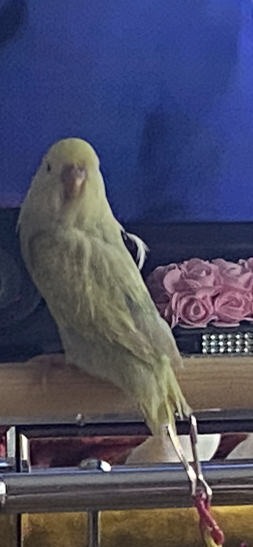
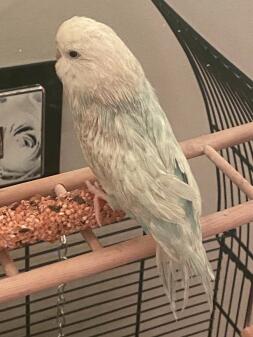
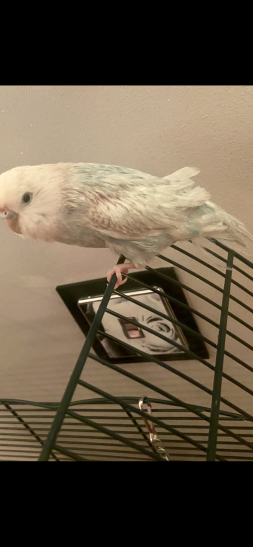
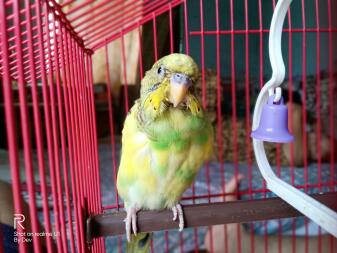
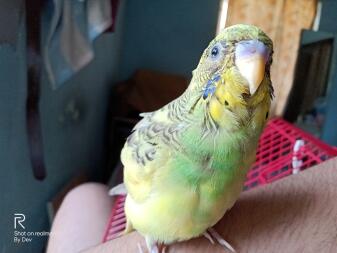
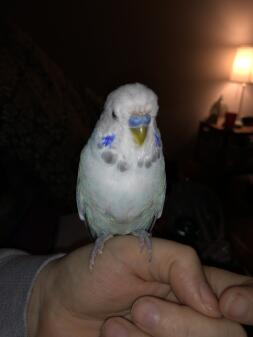
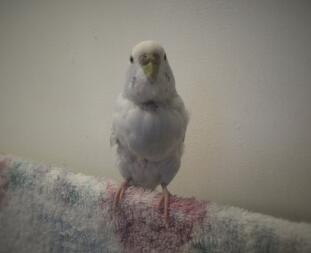
Comments
Emile, 1 November 2024
My budgie has pure white feathers and there's a yellow tint in them. I don't know if shes had it since we got her or if theres a parasite. But i need help. I've already lost two parakeets and I don't want to lose another. (also if you can recomend an exotic walk in vet too, that would be great!)
Constance, 20 January 2024
My parakeet lost feathers under his beak? What can I do?
Valentino, 23 December 2023
My budge is fit but feathers are not growing she can’t fly and her feathers looked dryer out any answers for this problem
Saira, 23 December 2023
My budgie lost most of her hairs. No grow back but she is active.
Jeff, 2 April 2023
I have two miniature Budgies, one is an Albino and the other is a beautiful hybrid green, yellow, black and blue. My problem is the Albino was very svelte and all in a beautiful bird to look at, then after the molting, she has developed some abnormal wing feathers. It is almost like she has too many on one side. I am tempted to do something bot don't know what.So, before the Vet trip, I thought I would ask here and if I can upload the pictures. I would certainly like some thoughts. Cheers